Though they’ve been around since 2014, 2022 has indeed been the year of the NFT — carrying the momentum the non-fungible tokens gained for themselves in 2021.
While the idea of digital collectibles confused many, there has been a proliferation of the practice of digital ownership that has established itself in society across the finance, art, and culture industries. From artists leveraging digital ownership as a means to expand their creative offerings, to currency going digital, the advent of Web3 is disrupting multiple landscapes with brands keeping careful watch.
While traditionally NFTs were developed and introduced as a store of value for investors to purchase with hopes of selling for a return, much in the same way that one might purchase a sculpture from a prominent artist, the practice of leveraging digital media for brands is much simpler and can equate more directly to the production of a digital product — although scarcity does play a prominent role in achieving success.
TL;DR:
1. What are NFTs?
2. Why should you care?
3. Use cases for brands
4. How to build a collection
What even is an NFT?
NFTs are digital assets that are stored and shared via blockchain which is an immutable digital distribution network that is communally validated. While that may seem like word soup to many, it basically just means that your NFT is a digital asset that has a specific solution to a complex math problem assigned to it which the ‘network’ has to check each time it moves to make sure it’s legit. The immutable part just means that it can’t be changed, it can move, but once it exists, it’s there forever. This is the same principle as Antoine Lavoisier’s theory of conservation of matter which states that “matter can neither be created nor destroyed” — essentially the same amount of stuff exists now as did at the time of the big bang, just in different forms.
The process is fairly simple, here’s a quick explanation of how it works:
1. A piece of digital art is created (or a digital representation of a physical piece of art)
2. A digital token is “minted” containing the location of the digital asset.
3. Once sold, this token is transferred to the digital wallet of the buyer — providing them custody of the digital piece.
It’s that simple — though we’ll go a bit more in-depth just because we’re NoGood like that.
Why NFTs?
They’re hard to fake:
If you’ve spent any time at all on the internet in recent history, you’ve likely seen someone comment about “copy + pasting” someone’s NFT. And while, yes, you can replicate these digital assets a bit easier than physical ones, the obstacle of forgery is not unique to NFTs — in fact, it’s arguably a larger issue for physical goods than digital ones since there’s no “loss” involved in someone copying a digital asset.
What NFTs do offer as a benefit, however, is the ability to trace the origins of any particular asset with a little bit of effort to validate its authenticity.
For brands operating in a space that is dominated by forgeries such as handbags, sneakers, and other collectibles, this provides a unique opportunity to harness NFTs as a means of certifying the authenticity of products.
Let’s say that Nike is releasing a new pair of Jordans and they want to leverage NFTs as a means of tracking sales and allowing resellers to prove that the sneakers they are selling are, in fact, legit. They might mint an NFT of the sneakers that are distributed with each sale with the corresponding hash printed on the sneaker, or on the receipt to validate that Sneaker X corresponds with NFT Y so that at any point if the sneaker is sold the has can be traced back to Nike as proof that it’s real.
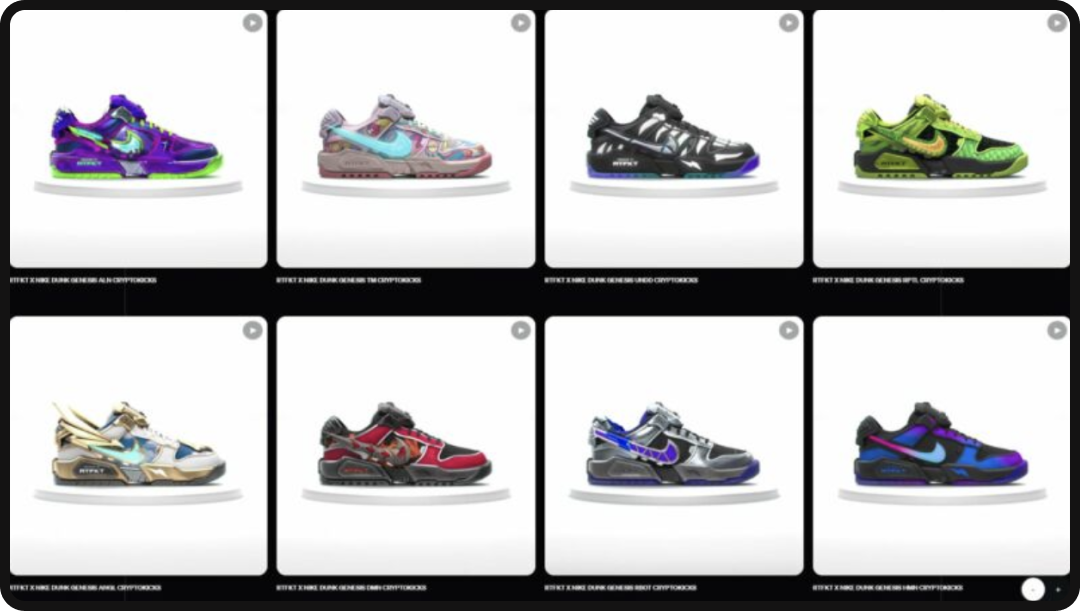
The same is true for any brand looking to utilize NFTs as branded digital assets, in that they can mint a collection of branded images or characters, and those specific pieces will all be unique and traceable back to the original creator — though this doesn’t stop digital ne’er do wells from copying assets and trying to sell them as original, so some due diligence is still required on the behalf of the buyer if they’re looking to ensure they’re getting a real NFT.
They’re lossless:
Like traditional wallets, digital wallets have become a place for storing memories as people continue to adopt the practice of collecting digital assets. As past generations have used their physical wallets to hold keepsakes and photographs, digital wallets can serve the same purpose for storing digital assets as something of a digital time capsule, or index, of their digital memories and possessions.
In keeping with the example of those Jordans, if you’re someone who collects sneakers, or someone who buys them to wear them despite the creases they may obtain in the process, NFTs can act as a record of pieces owned both past and present.
We often forget the things that we own, particularly since a pair of sneakers may only last us a few years before the soles wear out and they need to be retired or recycled.NFTs however, will be as crisp in 10 years as they are today. For brands, as a mechanism of building loyalty and as a provided benefit of allowing users to show off their collections from a historical perspective, providing NFTs of purchased items can act as a way of not only encouraging brand recall when customers open their wallets and fondly look through the plethora of other purchases they’ve made but also as an opportunity to show off.
Digital collections that mirror physical ones allow users to bring their collections with them anywhere they go. Sneakerheads at a sneaker convention can easily pull up their wallet and show off every single piece they currently own without having to swipe through their camera roll, or those at a fashion show can similarly show off their collection of handbags that they’ve carefully curated over the years.
These digital pieces keep brands top of mind, leveraging nostalgia and brand recall to encourage future purchases and repeat business. A user may forget a pair of sneakers that they once loved because they’re stuck in the back of a closet, were donated and forgotten, or recycled, but an NFT of the piece can serve as a constant reminder for years to come without any fraying or creasing.
Inclusive growth:
Branding, at its essence, is a mechanism for people to label themselves as a part of something that is larger than just them. Even those of us who choose not to wear brand labels on our clothes, or think that the Louis Vuitton monogram is cheesy, put ourselves into a specific category by doing so.
At their inception, NFTs were seen as digital collectibles, with digital artists adopting the format as a means of monetizing their work in a way that hadn’t previously been possible. Brands have since picked up on the trend of digital scarcity and have leveraged digital goods as a mechanism of inclusive growth.
In its simplest form, brands can mint a collection of digital assets, whether they be sneakers, trading cards, avatars, or other forms of digital assets, in limited quantities so that those who most align with the brand can either purchase them outright or enter into a raffle to be given a chance to buy one of the pieces when they drop.
These items then give the owners a sense of inclusivity, similar to having a sought-after piece from a sneaker or handbag collection, which they can display with pride either on social media, in their wallet, on an NFT display in their homes, or similar setting.
However, the scarcity model can also be leveraged as a part of a reward system that ties more directly into traditional NFT formats — creating a roadmap and different tiers of access or reward based on interactions, purchases, or other brand loyalty metrics.
What is a roadmap?
In traditional NFT ecosystems, roadmaps are developed as promissory notes of sorts to those buying into the project. They essentially lay out the path forward to let buyers know what return they can expect, and when. This return can come in the form of rewards, future functionality like a metaverse experience or game, the development of a cryptocurrency or governance token, or other sorts of additional benefits.
This is unique to traditional NFTs because they are generally seen as an investment piece, rather than a mechanism for brand loyalty, putting emphasis on the ways that the initial minting will lead to the raising of funds for future developments which will provide additional returns to those who invest early.
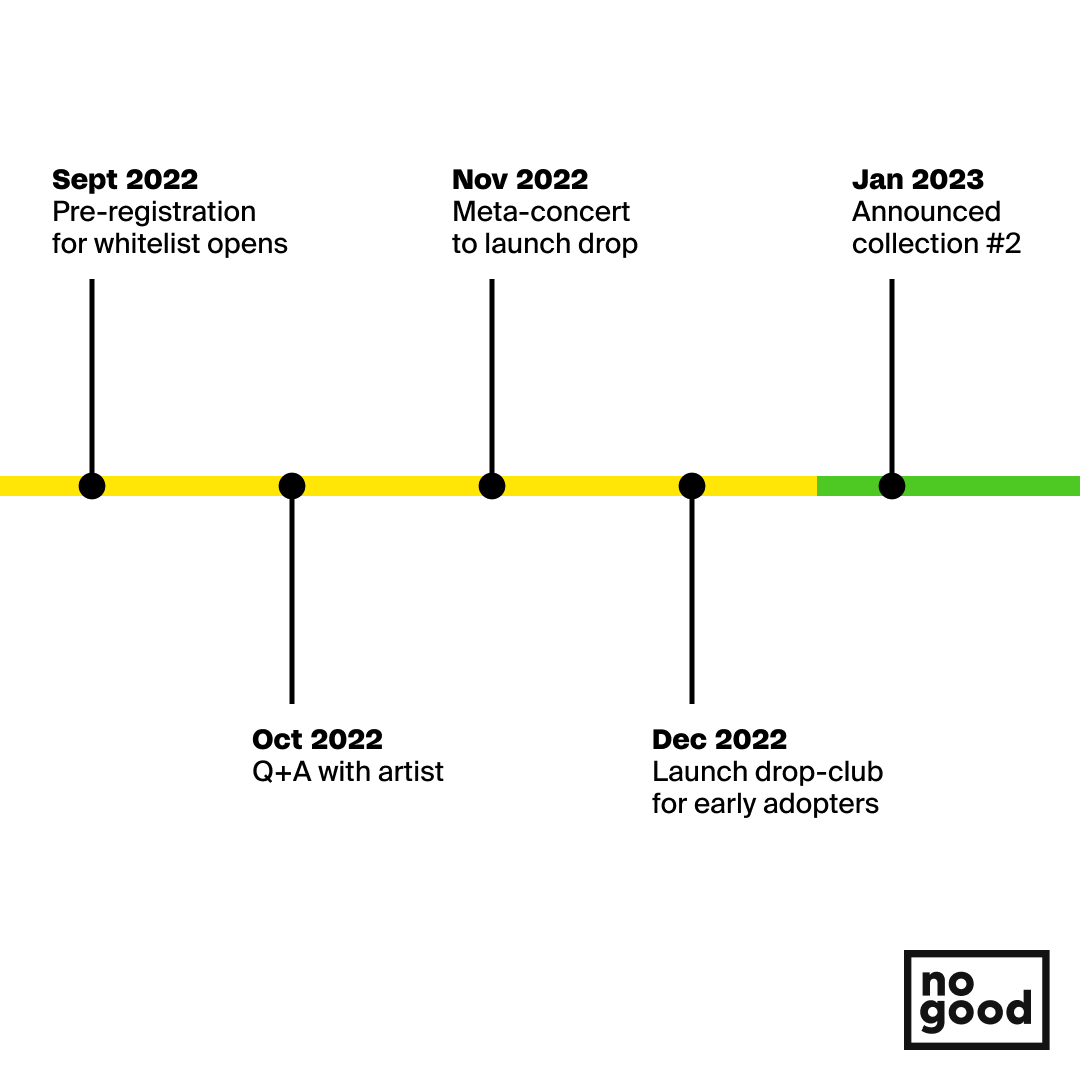
While this process doesn’t necessarily translate directly to brand experiences, since those purchasing a product, even if limited and as an investment, don’t necessarily need to see any proof or promise of return outside of the actual product itself — most customers know the category they’re buying into enough to understand what potential returns they’ll make.
This concept, however, can be leveraged as a tiered reward system with different levels of access built into it for customers who spend a certain amount or make a certain volume of purchases.
If we were to look at the model of the Frequent Flyer program as an example, we could use NFTs as a mechanism for access with each flight ticket purchase being distributed directly to the user as an NFT. As customers build loyalty and accrue more flights, they can be distributed tiered NFT “badges” which they can carry in their wallets and grant them access to perks and rewards.
Those who have flown 10k miles may get a green NFT badge which they can use to access early check-in, while those who have flown 100k miles may get a platinum NFT badge which allows them access to a premier metaverse lounge which they can access both before and during the flight to interact with other platinum badge holders.
The roadmap here isn’t necessarily tied to any immediate monetary return for the person who is accumulating miles as a part of the program, but the benefits do stack as they move up the tiers of different badges and they can keep them displayed prominently in their wallet, or even on social media for clout and recognition.
The takeaway here is that the roadmap model can be translated into a brand ecosystem for brands looking to harness NFTs as a means of building loyalty — but with slightly different goals and outcomes. If a brand wanted to develop a metaverse game as a part of their roadmap for the future of their NFT collection, they’re absolutely welcome to, it would just be best leveraged as a perk that’s locked behind a loyalty program, rather than a promissory future return on investment.
Promotion and community:
Brands looking to leverage NFTs as a lever for awareness and loyalty have a fairly significant advantage over those simply entering the space as a means to promote a new collection or project due to having a presumed pre-existing community and following on social media. This not only cuts out the process of having to build a community, or infiltrate the NFT community to gain their trust and support for a project, but also expands the potential buying pool significantly as it’s not limited to just those who want to buy NFTs.
A branded NFT collection may actually act more so as a bridge to adoption for those who may be curious about NFTs, or have previously heard about them but wasn’t quite sure what they were, as brand loyalty may act as the main driver to adoption.
Using streetwear superbrand, Supreme, as an example, there is historical precedence that it is much easier to drive customers to new product categories through an existing brand than it is to drive them to new product categories through unproven or unknown brands due to the lack of established trust and authority.
Supreme has adorned everything from bricks to Oreos, to bolt cutters, with their universally recognizable box logo — all to great success.
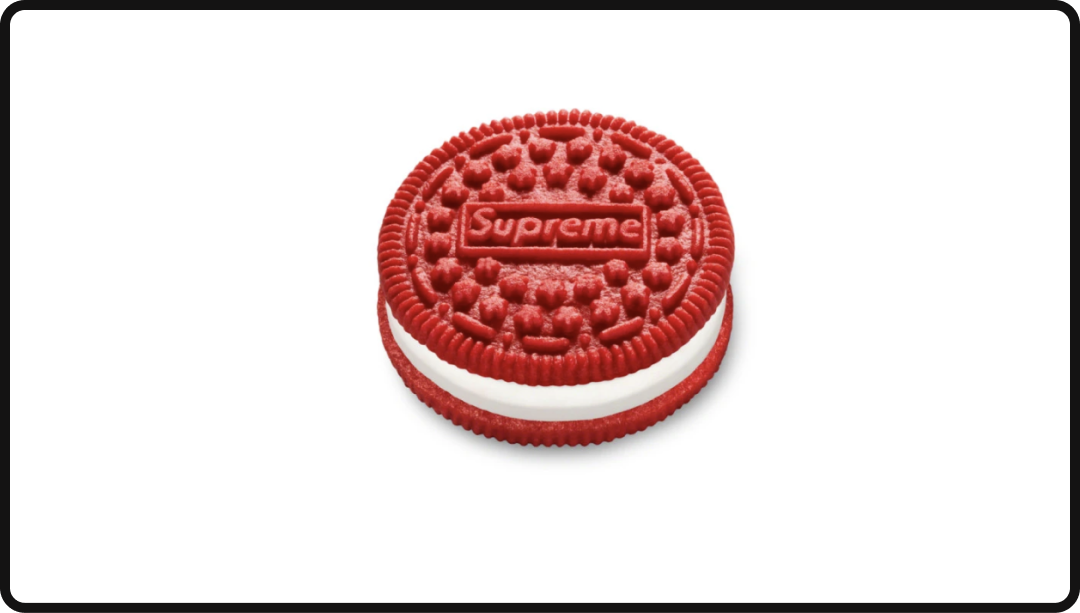
For brands entering the NFT space, it becomes a practice of leveraging existing audiences and brand recognition to buy into your limited release of digital assets rather than having to go through the difficult process of building a community to then sell to.
This is the way:
Build a website:
If you already have a brand, it’s also likely that you have developed domain authority which can be easily leveraged as a means to drive traffic to promote your NFT collection, or at least gauge whether or not it’s worth pursuing by way of seeing if there’s already search intent for branded NFTs from your brand.
Using Supreme again as an example, a quick Google search shows us that there’s already a fairly substantial search volume for “Supreme NFT” which is less surprising than the fact that they haven’t released an NFT collection yet considering, while we hadn’t previously thought about it, now that we are we’re pretty sure it’d sell really well.

Your web presence, however, can serve a number of different purposes, whether it’s a new page on your site or a separate landing page that you built specifically for your NFT project.
Either way, it’s important that this website details the what, why, and when of your NFT project for the following reasons.
Upon landing on your page, the user is going to want to know, and you’ll want to answer in order to gain their interest, what sort of NFT collection you’re releasing.
Landing pages to answer what:
This will vary depending on your brand, and what the brand goals are, but like anything else it’s important to consider your audience, what they would be most likely to respond to and buy into, their budget, etc.
It’s recommended that this page be fully developed and thought through with every aspect of the NFT project displayed for those who might find it in order to ensure that you gain trust from audiences and drive interest early on. The page doesn’t need to detail exactly what each piece is going to be as you may want to keep some of the pieces a surprise to add mystery and suspense to the project, though showing a few samples of what to expect from the collection, the drop calendar (exactly what it sounds like, a calendar for when pieces will become available), any outside collaborators who may be involved, where the pieces can be purchased, or any other details that may help to drive sales, interest, and shares.
Create a drop calendar to answer when:
A drop calendar is a useful tool for maintaining intrigue, suspense, and engagement. While collections have historically (in some cases) been dropped all at once with a certain number of pieces that are either pre-created or randomized at a certain volume for buyers to snatch up hoping they get a piece that is highly sought after (like a digital gumball machine), there is also a slow-drip approach that has proven favorable to sustain interest.
Spacing out the release over a period of weeks allows not only for brands to maintain energy levels and engagement for the product as they leverage their social channels, email lists, blog pages, and other forms of media to push out updates on the project as its being released to the public, but also to incorporate other community mechanisms to help drive interest.
This can take the form of content creators hosting pre-launch giveaways of rare pieces, live or meta events with prominent artists or musicians, previews or beta-tests of future roadmap features (ie; early access to your web3 game to upsell audiences), or any other variety of ways to keep the community engaged.
Having a purpose to tell users why:
This is a big one — particularly as the space becomes increasingly saturated.
This is not unique to NFTs, as anytime we embark on a new project, the response of, “We wanted to.” is never satisfactory to the question of, “Why?” There needs to be a narrative that is driving your NFT project that will resonate with your community and drive them to purchase from your drop. This could be anything from an artist collaboration where the story is that “X artist approached us and wanted to work on a collaboration and NFTs just made sense for the partnership.” to the release of a new collection that you wanted to showcase through a new digital frame.
Whatever it is, the why must be at the center of every touch point that your brand makes from announcement to drop. It’s this story that will drive intent, drive advocacy, and ultimately drive success.
Preparing for launch:
The components of your drop calendar? They all come in here. This section will act as something of a pre-launch checklist, or suggestion list, for preparing your audience and your collection for the big day(s) when it finally drops.
Choosing a Marketplace:
The decision of which marketplace to sell your collection on may seem daunting but it’s really not that big of a deal unless you happen to have some sort of data that supports your community preferring one over the other. Opeansea.io is generally the most popular and has hosted drops from brands ranging from Care Bears, to Bose collabs, to ADIDAS with their Into the Metaverse collection — though that doesn’t necessarily mean that Rarible which has sold Nike collabs, or SuperRare which specializes more in creator-driven projects should be completely discounted. Ultimately, an audit of the marketplace options is recommended to see if there’s one particular marketplace that resonates most directly with your project, and if not then just go with whichever has the largest user base.
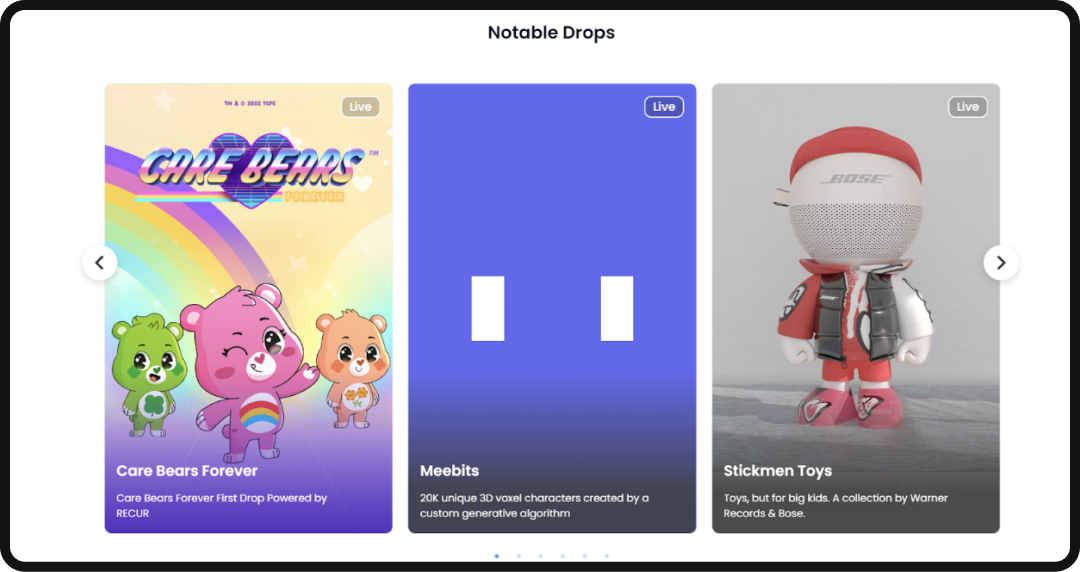
Leveraging Community:
While most NFT guides will encourage diving deep into the depths of Discord to connect with the NFT community and drive interest and authority for your collection, we’re probably going to forego that step of the process for this particular guide — and with good reason.
While the option is there, we’re more so focusing here on selling a brand experience than we are trying to appeal to the NFT community at large. While it is our goal to sell as many, if not all of the NFTs we’re minting as a part of the drop, there is something to be said about having too much success, or attracting NFT whales who will drive away brand loyalists who will be discouraged if they’re unable to get anything from the drop.
Ultimately, if the project gains enough traction, then it’s likely the NFT community will catch wind of it, and those interested or who see the earnings potential from purchasing from the drop will likely spread the word, but for the purpose of brand loyalty and awareness, sticking to existing social media channels may be the best approach to immediately reward the loyalty of your community.
Whitelisting to encourage early adoption:
Whitelisting is a mechanism used to capture user data and encourage early interactions and adoptions which can be an incredibly helpful way to give preferred access to existing supporters of your brand through any means of social campaigns that aim to specifically target existing followers, customers, or subscribers.
By taking a community-first approach to your NFT drop, you can ensure that your efforts to leverage brand loyalty go further.
By running campaigns to those already invested in your brand, you can give them the right of first refusal to be whitelisted for early access to prioritize those with existing accounts, or an established history with the brand.
This is also a fantastic mechanism to gauge interest by measuring how much traction is being given through the whitelist campaigns, which can later inform decisions about rolling out to broader audiences or more directly targeting those in the NFT community at large.
Social + email campaigns to drive awareness:
Nothing groundbreaking here, these platforms simply provide opportunities to roll out content targeted to existing audiences to hype up the collection, gauge interest, encourage interactions, and educate your audience on the collection and who and/or what is involved.
These can be rolled out in the weeks, or months, prior to the drop to encourage those already following you to get whitelisted, create accounts on the marketplace where you’ll be selling the collection, or otherwise take preparatory steps to align your audience with the mechanisms of blockchain if they may not be intimately familiar with them.
This is also a great opportunity to leverage collaborators, content creators, or other forms of aligned accounts in order to reach wider audiences who may take interest in your NFT project.
Paid media to reach new audiences:
While there are paid media platforms specifically geared towards NFT like NFT Pump and NFT Launches, there may or may not be a reason to leverage them for the purposes of driving interest in your branded NFT launch as they would specifically be targeting those who are primarily invested in NFTs as a culture who may or may not overlap into audiences that align with your brand.
If your preliminary campaigns to drive whitelist initiatives come up short, it may be worth leveraging an NFT-specific ad platform or service rather than traditional social ads, as social advertising platforms may fall precariously somewhere between audiences that are primarily brand-driven, and the NFT-driven audiences that would be targeted on platforms like NFT Pump — likely being too distanced from either extreme to garner any meaningful results.
If the decision is made to target the NFT community specifically, these services are incredibly unique in that they provide fairly specialized leveraging of existing communities to promote projects, targeting specific audiences through customized campaigns on Twitter, Discord, or other social platforms that are predisposed to being Web3 enthusiasts in order to help drive awareness within highly targeted, highly engaged communities.
A branded whitepaper for authority:
While whitepapers are somewhat of an integral part of any NFT or crypto launch, they generally act as a technical document that outlines the intention of the project, what problem it’s looking to solve, and how it means to get there.
Depending on your brand, and what you’re trying to achieve with your NFT project, the problem may only amount to, “There aren’t any (insert_brand_name) NFTs.” This is totally fine.
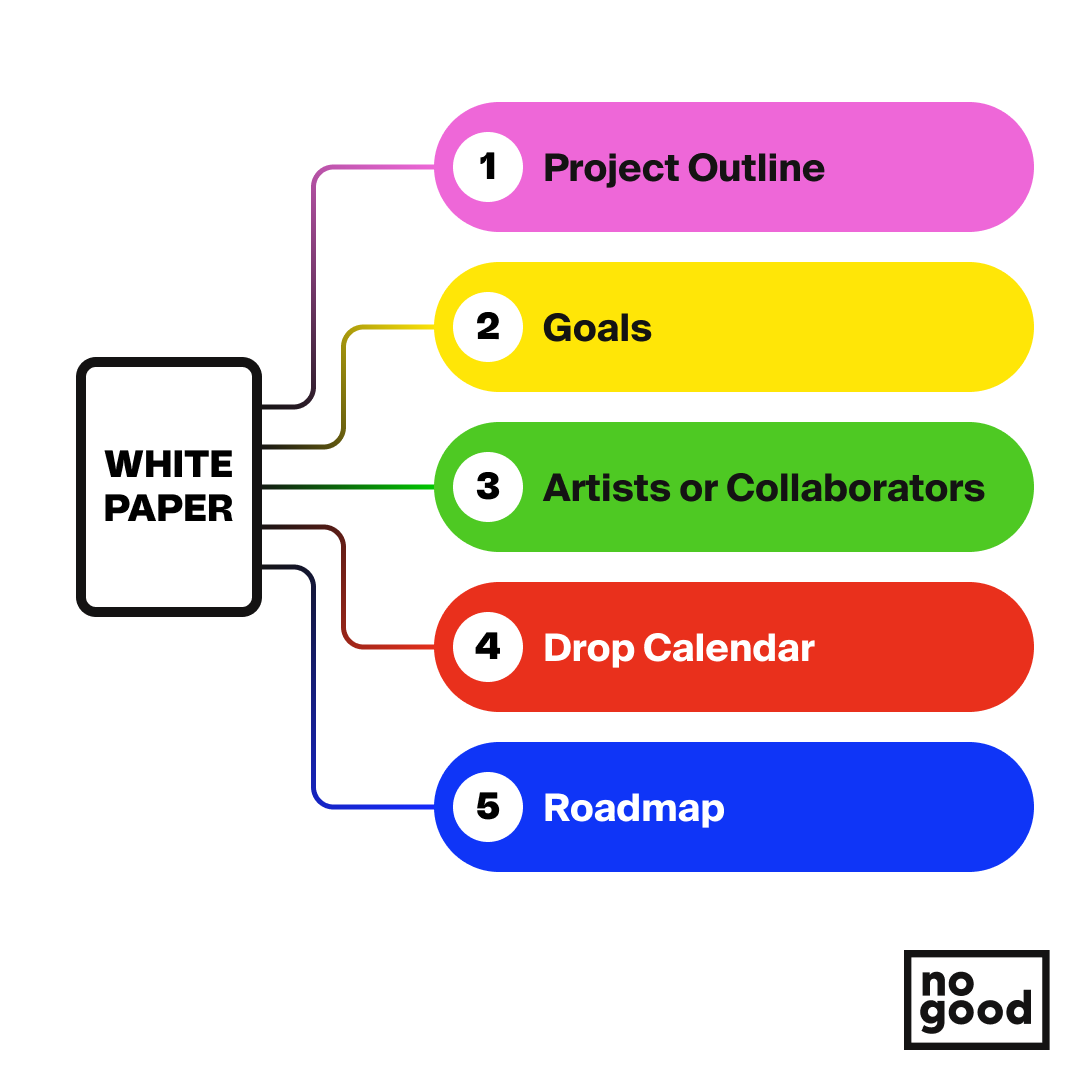
This isn’t to say that you can’t leverage the whitepaper format as a piece of brand collateral, since they tend to get passed around in certain circles around the blockchain, and if it’s a compelling piece of PR then it can only help to drive interest and get much-needed eyeballs on the project you’re looking to build and promote.
The Launch:
Honestly, this is the most stressful, but easiest part of the entire process, and if you’re using Opensea.io or a similar platform for your launch then you’ve likely uploaded your NFTs weeks ago, set your floor prices (minimum sale price for the launch), and gone through the various due diligences of your pre-launch
By the time that launch day comes, you’ll likely have a very good sense of how it’s going to go based on how many people have signed up for your whitelist, the success of your give-aways, the engagement you received on your social and email campaigns, and even possibly the resale price of the pre-launch give-aways.
All there is to do at this point is to sit back, relax, and maybe host a live-stream event as you track sales and monitor social chatter to gauge sentiment and see if you start trending on Twitter so you can get in on those conversations and enjoy the benefits of all of the hard work that led up t to this point.
That is, until…
Post-Launch:
Who would we be if we didn’t mention test, measure, and iterate at least once per blog post? This is it!
Once the drop calendar has run through its paces, and all of the pieces have been released and (ideally) sold, it’s time to reflect on the learnings and determine what, if anything, to do next.
Sub-collections can be a natural next step in the process if the collection did well and sold out, as they simply expand the initial offering with some slight nuances to set this collection apart from the previous one. This can take the form of gearing the future collection towards a different season, holiday, or event, or expanding the offering into new categories — in the example of the Jordan NFTs, we could expand that collection into additional colorways or silhouettes depending on what was included in the initial offering.
Throwing it back to the roadmap, expansions can be made here to easily scale up the loyalty aspect of the NFT release, including additional rewards or future perks for those at the various tiers of your program to encourage interest in future collections or drive sales of soon to come sub-collections.
And of course, new collaborations and expansions to bring your brand further into the metaverse can be a great next step — further leveraging blockchain to build brand awareness. If your initial release was successful, and you want to continue building into the space for brand awareness, increasing the overlap between those who are web3 enthusiasts, and those who are brand loyalists, you can seek out prominent artists and creators within the NFT space to work with directly on your next collection and leverage their reach to ensure that the Doodles x Nike Jordan NFT collection completely destroys the internet.
What have we learned?
If we’ve learned anything through this process, it’s that branded NFTs show an immense amount of promise as a future (and honestly present) mechanism for building brand awareness and bridging the gap between the physical and digital worlds.
As with anything, the WHY is of immense importance when launching your NFT campaign, and of course, listening to your existing audience to ensure that you’re producing something that resonates with them and they’ll actually be interested in buying and later showing off to their friends.
We’re extremely optimistic for the future of digital assets, the interesting and compelling projects that will be born as an extension of their rise to prominence, and of course to continue helping incredible brands leverage this incredible new tool for building loyalty and awareness.





